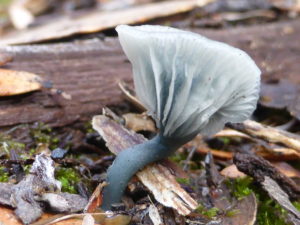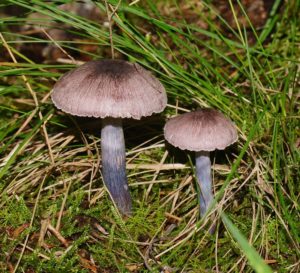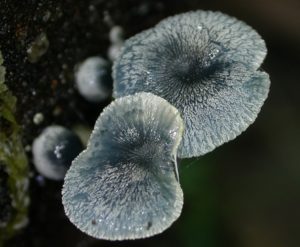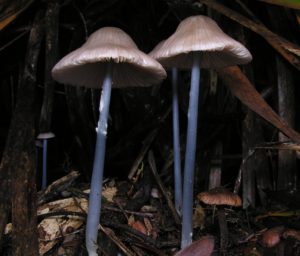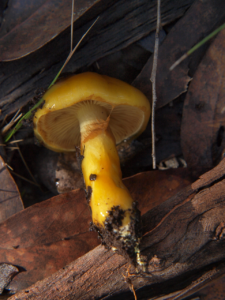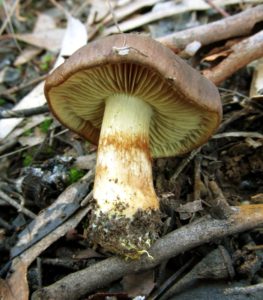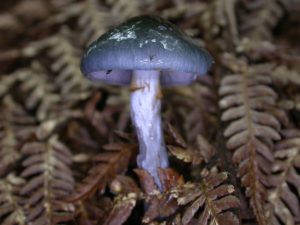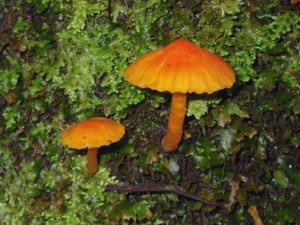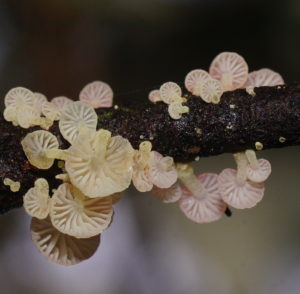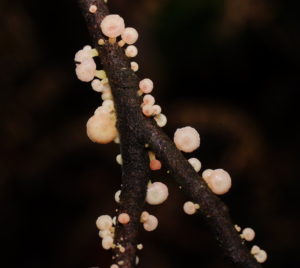Fungi come in many shapes and sizes. The gilled fungi or Agarics, widely known as ‘mushrooms and toadstools’ are very common. Here are some profiles of likely rare and threatened mushroom-shaped fungi.
- Green-gilled Amanitas – Amanita austroviridis group
- Blue-grey Navel – Arrhenia aff. chlorocyanea
- Grey Jockey – Asterophora mirabilis
- Yellow Skinhead- Cortinarius canarius
- Steel-blue Rozites – Cortinarius metallicus
- Warrandyte Waxcap – Hygrocybe sp. ‘Warrandyte JCR2’
- Sunrise Bonnet – Mycena roseoflava
Green-gilled Amanitas – Amanita austroviridis group
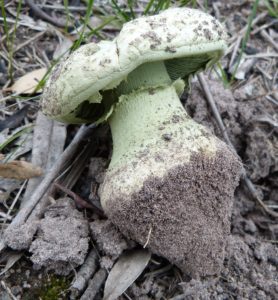
There are two named green spored and gilled Amanita in Australia Amanita austroviridis (MAP) and A. chlorophylla (MAP), it is not yet known if these are the same or similar species.
Fruit-body Description:
Pileus (Cap) Diameter to 90 mm or more; at first convex, then flat convex or centrally depressed; covered with pale olive-green velar remnants; margin appendiculate. Lamellae (Gills) Attachment adnexed, becoming free; closely spaced; colour deep olive-green; margins paler to almost white. Stipe (Stem) Central; generally up to 120 mm long and 20 mm thick; with fine fibrillose hairs and a bulbous base; colour off-white to pale green. Annulus fragile, membranous, often present as fragments; buff to pale green. Volva absent. Spore Print green.
Microscopic Features:
Basidiospores 9–11 × 5–7 µm, elongate, smooth. Basidia four-spored, 45–55 × 11–15 µm, clavate. Clamp connections present.
Notes:
This mycorrhizal basidiomycete; found growing singly or in small groups on sandy soils in coastal scrubland, usually in association with Casuarina trees.
References:

*Text adapted from references.
*Bougher NL and Syme K 1998 Fungi of Southern Australia. University of Western Australia Press: Nedlands. p. 158
*Grey P and Grey E 2005 Fungi down under: the Fungimap guide to Australian fungi. Fungimap: South Yarra, Victoria. p. 18
Hubregtse, J CC-BY-NC-SA 2018 Fungi in Australia, Revision 2.1. Field Naturalists Club of Victoria Inc. E-published at FNCV.
Look-alikes:
Green-gilled Parasol (Chlorophyllum molybdites) is another large Agaric that has a green spore print but the gills are more a leaden, grey-green and stem is tall and skinny.
Blue-grey Navel – Arrhenia aff. chlorocyanea
This small mushroom is blue-grey to pale grey, usually found in a moss or algal mat. This is most likely an un-named Australian species with similarity to the northern hemisphere Verdigris Navel (A. chlorocyanea), which is more often darker green-blue, thicker gills and usually more symmetrical.
Fruit-body Description:
Cap 2-18 mm diam., irregularly infundibuliform to flat with a depressed centre, margins upturned but often just inrolled, blue-grey to pale grey, dry, translucent-striate across the cap, usually with an upturned cap margin and depressed centre in older specimens. Younger specimens tend to be flat with margins just upturned. Gills adnate to sub-decurrent, close, typically similar colour to cap but paler, with more short gills at the margin. Stem central to eccentric 1-4 mm wide up to 15 mm tall, dry, smooth often with pale bloom at the base. White spore print.
References:
iNaturalist 2019 Species pages for Arrhenia chlorocyanea. Accessed 11 April 2019.
Encyclopedia of Life 2019 Species pages for Arrhenia chlorocyanea. Accessed 11 April 2019.
Look alikes:
Other grey to blue-grey gilled fungi like Waxcaps, Lichenomphalias, and Omphalinas. Entolomas have pink spore prints and are often larger. Mycena interrupta maybe recognised as this is on wood and has a basal disc. Hygrocybe griseoramosa also found in moss mats but has lilac tints rather than blue-grey.
Grey Jockey – Asterophora mirabilis
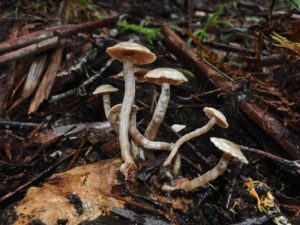
John Eichler)
This very small parasitic species has a silvery-grey to bone-coloured cap and stem and light brown gills. Found in the cool temperate rainforests of Victoria and Tasmania (MAP). This is unusual as it lives of the remains of other fungi the Brittle Gills which are fungi that below to the family Russulaceae, these old fruit bodies maybe blackened or almost gone, so can appear to be on the ground.
Fruit-body Description*:
Cap diameter up to 30 mm; convex, broadly convex to almost plane; surface dry; colour brownish to greyish, covered in a flattened layer of fine silvery grey fibrils. Gills attachment adnate with decurrent tooth; moderately crowded; colour light brown. Stem central; generally up to 35 mm long and 3 mm thick; same colour as pileus; covered in a flattened longitudinal layer of fine silvery grey fibrils, often grows in caespitose colonies. Spore print white.
Microscopic Features:
Basidiospores 5–6 × 3–4 µm, ellipsoidal, smooth. Basidia four-spored, 19–23 × 5–7 µm, clavate.
References:
*Text adapted from references.
*Grey P and Grey E 2005 Fungi down under: the Fungimap guide to Australian fungi. Fungimap: South Yarra, Victoria. p. 18
*Hubregtse, J CC-BY-NC-SA 2018 Fungi in Australia, Revision 2.1. Field Naturalists Club of Victoria Inc. E-published at FNCV.
Look alikes:
The combination of characteristics make this dull-coloured species recognisable, particularly the combination of small size, often clumped (caespitose) stems with fine distinctly longitudinal fibrils and the remains for the host fungus.
Yellow Skinhead – Cortinarius canarius
Cortinarius canarius is readily identified by its bright yellow colour, stout and dry fruit-body. Found in wet forests and rainforests (MAP), and its mycrorrhizal partners are likely to be eucalypts and Nothofagus spp.
Fruit-body Description*:
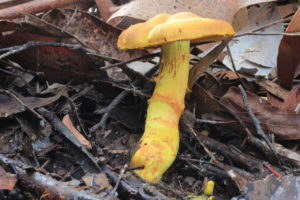
Cap diameter to 60 mm or more; when young hemispherical becoming convex, centre broadly umbonate; surface dry, minutely to coarsely fibrillose; colour bright yellow. Chemical test application of KOH solution produces a red to red-brown colour reaction. Gills attachment sharply adnexed, sometimes with a decurrent tooth; crowded; colour at first golden yellow, becoming yellow-brown as spores mature. Stem Central; generally up to 80 mm long and 30 mm thick; stout, slightly bulbous with root-like base; surface dry, smooth; colour yellow. Cortina membranous to thick, cobweb-like, yellow, leaving an annulus or collapsing to 1 to 3 robust fibrillose zones towards the base of the stipe; usually stained yellow-brown from spore deposit. Spore Print brown.
Microscopic Features:
Basidiospores 7.5–8.5 × 4–5 µm, ovoid, minutely rough with projections at apex. Basidia four-spored, 20–35 × 6–8 µm, clavate. Clamp connections present.
References:
*Text adapted from references.
Hubregtse1, J CC-BY-NC-SA 2018 Fungi in Australia, Revision 2.1. Field Naturalists Club of Victoria Inc. E-published at FNCV.
Look alikes:
Another bright yellow species is Cortinarius sinapicolor, this has sticky cap and stem. There are other dry and brown or dull that may have bright gills, or cap or stem like Cortinarius clelandii.
Steel-blue Rozites – Cortinarius metallicus
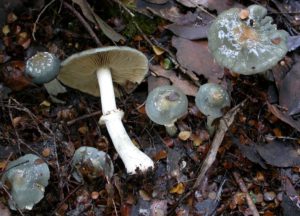
This large purple-grey, often slimy-capped mushroom has a large distinctive ring and veil fragments on the cap which are unusual for this genus. Found in rainforest (MAP), among leaf litter of Myrtle Beech (Nothofagus cunninghamii).
Fruit-body Description*:
Cap diameter to 140 mm or more; initially convex or parabolic, with age expanding to plane with a broad umbo, margin translucent striate, eroded, becoming radially wrinkled with age; surface smooth, glutinous, sometimes with patches (remnants of the universal veil); colour initially uniformly bluish grey; with age fading to pale grey and central region becoming tan to yellowish brown; brown colour then expanding towards the margin; markedly hygrophanous. Gills attachment adnexed with small decurrent tooth; crowded; colour at first cream with a slight greenish tinge, gradually becoming tan as spores mature. Stem central; generally up to 150 mm long and 15 mm thick; stout, swollen towards the base, has white mycelium at the base; surface dry, shiny, has longitudinal fibrils; colour white, stains brownish. Annulus white, smooth to striate, membranous, becoming rust-brown as it collects spores. Spore Print brown.
Microscopic Features:
Basidiospores 9.5–12 × 7.5–8.5 µm, broad ellipsoidal (almond-shaped), coarsely ornamented, warty. Basidia four-spored, 32–41 × 10–14 µm, clavate. Clamp connections present.
References:
*Text adapted from references.
*Grey P and Grey E 2005 Fungi down under: the Fungimap guide to Australian fungi. Fungimap: South Yarra, Victoria.
*Hubregtse, J CC-BY-NC-SA 2018 Fungi in Australia, Revision 2.1. Field Naturalists Club of Victoria Inc. E-published at FNCV.
Look alikes:
There are many slimy purple-grey Cortinarius including C. rotundisporus but these have smaller wispy rings called a cortina. The Rozites group have the larger more distinctive ring.
Warrandyte Waxcap – Hygrocybe sp. ‘Warrandyte JCR2’

This conical orange Waxcap is found among moss mats in Burgan thickets along the upper Yarra river. Only known from this area so far. With a slightly sticky cap and stem, young specimens that have a fluffy yellow stem covering are most recognisable.
Fruit-body Description*:
Pileus 10–20 mm diam., obtusely conical to conical, smooth or very finely squamulose in dry conditions, dry, bright scarlet, fading a little with age; margin even to subcrenulate and striate, yellowish. Lamellae broadly adnate, often with a decurrent tooth, thick, distant, buff-pink; margins even, concolorous. Stipe 30–40 × 3–4 mm, cylindrical, smooth, with a fine yellowish-pruinose layer ±covering the stipe surface, becoming more scattered and flocculose with maturity, dry, hollow, orange-yellow but sometimes pink-tinted.
Microscopic Features*:
Basidiospores ellipsoidal to obovoid or subcylindrical, 8.5–9.7–11.0 × 5.0–5.7–6.0 µm, hyaline; subcylindrical spores occasionally with small but distinct constrictions. Cheilocystidia and Pleurocystidia absent. Hymenophoral trama regular, consisting of cylindrical and inflated moniliform elements 30–100 × 5–27 µm, thin-walled, hyaline; oleiferous hyphae sometimes present, highly refractive, branching, often contorted, 4.0–8.5 µm diam.; clamp connections present. Pileipellis a cutis of cylindrical but somewhat inflated hyphae 3–9 µm diam., thin-walled, hyaline, sometimes weakly gelatinised; oleiferous hyphae; clamp connections present. Stipitipellis a cutis of cylindrical hyphae 2.5–5.0 µm diam., thin-walled, hyaline; clamp connections present. Caulocystidia present as hyphal fascicles up to 100 µm high, consisting of tangled or contorted cylindrical hyphae 3–5 µm diam., thin-walled, hyaline, rounded at the apices; clamp connections present.
References:
*Text adapted from references.
Fuhrer, B. (2005). Field Guide to Australian Fungi, 2nd revised edn. Bloomings Books, Melbourne.
*Young, A.M. (2005). Fungi of Australia: Hygrophoraceae, ABRS, Canberra and CSIRO Publishing, Melbourne.
Look alikes:
With more than twenty known orange Waxcaps and many unknown, the species requires careful examination including microscopic characters to confirm identification.
Sunrise Bonnet – Mycena roseoflava
This small pink and yellow mushroom, the stem relatively short is often attached to the side of wood, usually with a slightly swollen stem base. Grows on standing and fallen dead wood, including twigs. This is rare in New South Wales, uncommon in Victoria where it has only found only in wetter forests and rainforests (MAP) but is more common in Tasmania.
Fruit-body Description*:
Pileus 2-10 mm diam., pink fading yellowish, hemispherical with a shallow central umbilicus, indistinctly striate, subfibrillose. Gills adnate to slightly decurrent, moderately distant. Stipe 5-10 x 1-2 mm, ochraceous to yellow, central to excentric, straight or curved, smooth to minutely floccose.
Microscopic Features:
Spores globose, 6-8 µm diam., amyloid, thin walled. Hymenophoral trama and tissue of pileus pseudo-amyloid, Cheilo- and pleurocystidia ornamented.
References*:
*Text adapted from references.
*Stevenson, G. 1964 ‘The Agaricales of New Zealand: V’. Kew Bulletin 19(1): 1-59.
T.E.R:R.A.I.N. 2019 Taranaki Educational Resource: Research, Analysis and Information Network. Accessed 11 April 2019
Look alikes:
There are other pink laterally attached mushrooms like Scytinotus longinquus (syn. Panellus longinquus) but this has a sticky cap and thicker stem. Also Little Stinker (Marasmiellus affixus) but this typically smells bad and has a bleached mat and sometimes algae across the substrate.



